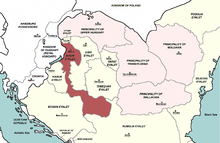| Province of Budin (Buda) | |||||||||||||||||
|---|---|---|---|---|---|---|---|---|---|---|---|---|---|---|---|---|---|
| Eyalet of Ottoman Empire | |||||||||||||||||
| 1541–1686 | |||||||||||||||||
 The Budin Eyalet in 1683 | |||||||||||||||||
| Capital | Budin (Hungarian: Buda) | ||||||||||||||||
| Area | |||||||||||||||||
| • Coordinates | 47°28′N 19°03′E / 47.467°N 19.050°E | ||||||||||||||||
| • Type | Eyalet | ||||||||||||||||
| History | |||||||||||||||||
| 1541 | |||||||||||||||||
| 1686 | |||||||||||||||||
| |||||||||||||||||
| Today part of | Slovakia Hungary Croatia Serbia | ||||||||||||||||
Budin Eyalet (also known as Province of Budin/Buda or Pashalik of Budin/Buda, Ottoman Turkish: ایالت بودین, romanized: Eyālet-i Budin[1]) was an administrative territorial entity of the Ottoman Empire in Central Europe and the Balkans. It was formed on the territories that Ottoman Empire conquered from the medieval Kingdom of Hungary and Serbian Despotate. The capital of the Budin Province was Budin (Hungarian: Buda).[2]
Population of the province was ethnically and religiously diverse and included Hungarians, Croats, Serbs, Slovaks, Muslims of various ethnic origins (living mainly in the cities)[3] and others (Jews, Romani, etc.). The city of Buda itself became majority Muslim during the seventeenth century, largely through the immigration of Balkan Muslims.[4]
- ^ "Some Provinces of the Ottoman Empire". Geonames.de. Archived from the original on 28 September 2013. Retrieved 25 February 2013.
- ^ O'Sullivan, Michael (1 May 2018). Patrick Leigh Fermor: Noble Encounters between Budapest and Transylvania. Central European University Press. p. 27. ISBN 978-615-5225-64-2.
- ^ Sluglett, Peter; Currie, Andrew (30 January 2015). Atlas of Islamic History. Routledge. p. 54. ISBN 978-1-317-58897-9.
- ^ Faroqhi, Suraiya (1994). "Crisis and Change, 1590-1699". In İnalcık, Halil; Donald Quataert (eds.). An Economic and Social History of the Ottoman Empire, 1300-1914. Vol. 2. Cambridge University Press. p. 440. ISBN 0-521-57456-0.